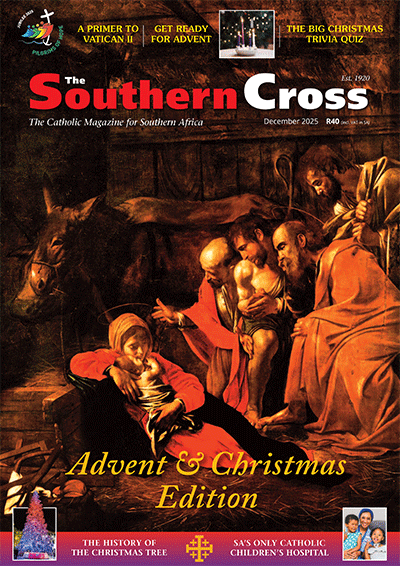The Most Holy Trinity Reflection

Franciscan Reflections From The Hermitage – The Most Holy Trinity – (John 3:16-18)
The disciples were absorbed in a discussion of the Master’s pronouncement, “Those who know do not say; Those who say do not know.” When the Master entered, they asked him exactly what these words meant. Said the Master, “Which of you knows the fragrance of a rose?” All of them knew. Then he said, “Put it into words.” All of them were silent.
Perhaps looking into the eyes of a lover or your newly born child, some of us may have experienced true gift love that changes forever who we are and how we see everything in the world. Some of us may even have seen the heroic power of gift Love that transcends all selfishness and even time itself. We may even have known the pain of giving oneself in unanswered gift Love.
Great poems have been written; wonderful monuments have been erected, and ballads have been sung to tell these stories. Yet without looking into the eyes of love, our reply also must be silence.
God, the Blessed Trinity, is a communion of Love… the Love of the Source which we call Father for an-other… the Love of the other who is the eternal and cosmic Word who took on flesh and whom we call the Son returning that love to the source… the Love itself as essence of the unity and joy between Father and Son and whom we call the Holy Spirit.
God’s Trinitarian Love is a Love which seeks to give itself… God loves in order to give God’s self. That is the nature of agape Love… it must give itself for the other.
Our Christian faith tells us that it is in the image and likeness of this Love that we were created… it is built into us, as it was built into the being of Jesus.
What can we say of this mystery of the Trinity … what may we say of the mystery of love … there must be a Lover and a Beloved and this gift between them that we call Love… like the scent of a rose!
Trinity, three, but actually only one! It was our Apostolic Father Tertullian, who, in the year AD213, created the word ‘Trinity’ to describe the nature and the essence of God. He could not have guessed that for the next 1500-year period arguments would continue grappling with this juxtaposition.
In the course of expounding his argument, he employed the word ‘personae’ to express the principle of plurality in the Christian notion of the Godhead. And with this word, he ranged the term ‘substantia’ in order to express the companion tenet of unity in the Christian God. This formula, ‘una substantia in Tribus personis’, ‘one substance in three persons’, soon came to have something like normative status in Western theology, and this status was achieved despite the fact that the apparent conciseness of the formula hides a real vagueness of meaning in its terms.
Within our Western theology, we have painted ourselves into a corner, writing off our own dynamic participation in Trinity in order to maintain God’s total immutability and transcendence outside of creation.
And now we have another new word given to us by the Spanish Catholic theologian Raimon Panikkar: Cosmotheandric (Cosmos/God/humanity).
He describes this cosmotheandric intuition as the totally integrated vision of the seamless fabric of the entire reality … the undivided consciousness of the totality. There are not three realities: God, Man, and the World; but neither is there one, whether God, Man, or World. Reality is cosmotheandric. It is our way of looking that makes reality appear to us at times under one aspect, at times under another; continually unfolding to horizons. God, Man, and World are, so to speak, in an intimate and constitutive collaboration to construct Reality, to make history advance, and to continue creation.
Just as the full humanity of Jesus was brought into unity with the Word, we also are called to bring our very self, our community, and the entire world into unity with the Trinitarian reality out of which everything arises. This does not require any additional ideology to impose on reality. In order to overcome our perspective which is narrowed down and fragmented, we need to open and hold a space of silence that overcomes our programming and touches our collective awareness of the transcendent reality. This is how we participate in the dynamic life of the Trinity.
Panikkar proposes living this new innocence that frees us from the longing for perfection, the longing to be better than the next, so as to open ourselves to this triple dimension of reality, open to others, to the world, and to God that we might achieve harmonious communion with them all: the cosmotheandric reconciliation. It is a matter of experience more mystical and ineffable than philosophic in the traditional sense.
“If the Christian message means something, it is this experience of the cosmotheandric reality of all being, of which Jesus Christ, true God, and true Man, is the paradigm and the blueprint. In Christ Matter is not on its own, nor is Man on one side and God on the other; none of these intrinsically united dimensions surpass the others so that it does not make sense to affirm that Christ is more divine than human or more worldly than heavenly. The veil of separation has been torn, and the integration of reality begins with the redemption of man” (Culto y secularización. Apuntes para una antropología litúrgica, Madrid 1979).
In the Franciscan intellectual tradition of St Bonaventure and Blessed John Duns Scotus, this understanding already started blossoming. Once we have experienced this imprint of God, we will see it everywhere in creation. For us as Franciscans, this is termed ‘panentheism’: all creation is a physical manifestation of God and is sacred, but this creation is not the totality of God, as ‘pantheism’ would claim.
This eternal wellspring of Love is so great that it spills over, as it were, and seeks to give itself… must give itself, because that is the nature of gift Love… giving itself away. This is why the cosmos is created, why angels were created… this is why we were created. Everything … all creation … each and every drop of water, mote of dust, and blade of grass … each moment of time and dimension of space… all is contained within this dynamic Trinitarian progression.
Our innermost desire to love and to be loved, to live in peace and to experience joy, participates in the divine desire of the Trinitarian blueprint of unfolding creation.
- The Church Year and Advent - December 1, 2024
- Easter Sunday Reflection: The Way – Love Overcomes Violence & Death - March 29, 2024
- Palm Sunday Reflection: Re-Espousing And Anointing - March 22, 2024




